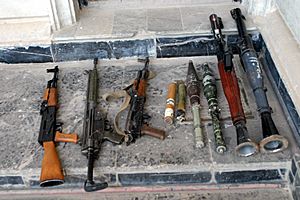Small arms facts for kids

Small arms are a type of gun that a single person can carry and use. They are designed to be light enough to be held by hand or supported by one person. This group includes many common firearms like pistols, shotguns, and rifles. Larger weapons, such as artillery pieces, are too heavy for one person to carry and operate.
Contents
What Are Small Arms?
Small arms are weapons that fire a projectile (like a bullet) using an explosive charge. They are different from larger weapons because of their size and how they are used. A key feature is that they are portable. This means they can be moved easily by soldiers or individuals.
How Small Arms Work
Most small arms work in a similar way. When you pull the trigger, a small hammer (called a firing pin) hits a primer. The primer then ignites a small amount of explosive powder inside a cartridge. This explosion creates a lot of gas very quickly. The gas pushes the bullet out of the barrel at high speed.
Parts of a Small Arm
Every small arm has a few main parts:
- Barrel: This is the tube the bullet travels through.
- Receiver: This is the main body that holds all the other parts together.
- Stock or Grip: This is where you hold the weapon.
- Trigger: This is the part you pull to fire the weapon.
- Magazine: This holds the bullets before they are loaded into the firing chamber.
Why Are Small Arms Important?
Small arms have been important throughout history. They are used by military forces and law enforcement around the world. They are also used for hunting, sport shooting, and self-defense in many places. Their portability makes them useful in many different situations.
Types of Small Arms
There are many different kinds of small arms. Each type is designed for a specific purpose.
Pistols
Pistols are small firearms designed to be held and fired with one hand. They are often used by police officers and for personal protection.
- Revolvers: These pistols have a rotating cylinder that holds the cartridges.
- Semi-automatic pistols: These use the force of the shot to automatically load the next cartridge.
Rifles
Rifles are long-barreled firearms usually fired from the shoulder. They are known for their accuracy over longer distances. The inside of a rifle barrel has spiral grooves called "rifling." This rifling makes the bullet spin as it leaves the barrel, which helps it fly straight.
- Bolt-action rifles: These are often used for hunting or target shooting. You manually load each round by moving a bolt.
- Semi-automatic rifles: These fire one shot with each pull of the trigger and automatically load the next round.
- Assault rifles: These are military rifles that can fire in both semi-automatic and automatic (continuous firing) modes.
Shotguns
Shotguns are firearms that usually fire a shell containing many small pellets (called "shot") or a single large projectile (called a "slug"). They are often used for hunting birds or for close-range defense.
- Pump-action shotguns: You manually pump a slide back and forth to load a new shell.
- Semi-automatic shotguns: These automatically load the next shell after each shot.
History of Small Arms
The idea of small arms goes back hundreds of years. Early firearms were very simple.
Early Firearms
The first firearms appeared in China around the 10th century. These were simple tubes that fired projectiles using gunpowder. They were very basic and not very accurate.
- Hand cannons: These were some of the earliest portable firearms. They were essentially small cannons held by hand.
Development and Improvement
Over time, firearms became more advanced.
- Matchlock and Flintlock: In the 15th and 16th centuries, new firing mechanisms like the matchlock and flintlock made firearms more reliable.
- Percussion caps: In the 19th century, percussion caps replaced flintlocks, making firearms even more dependable and waterproof.
- Cartridges: The invention of the self-contained cartridge (bullet, powder, and primer all in one unit) in the mid-1800s was a huge step forward. It made loading much faster and easier.
Modern Small Arms
The 20th century saw rapid development in small arms technology.
- Automatic and semi-automatic weapons: The invention of automatic and semi-automatic mechanisms changed warfare. These weapons could fire many rounds quickly.
- New materials: Modern small arms often use lightweight materials like plastics and alloys, making them lighter and stronger.
Safety and Regulations
Because small arms are powerful tools, their use is often regulated by laws. These laws aim to ensure safety and prevent misuse. Training is very important for anyone using a small arm. Learning how to handle, store, and use them safely is crucial.

